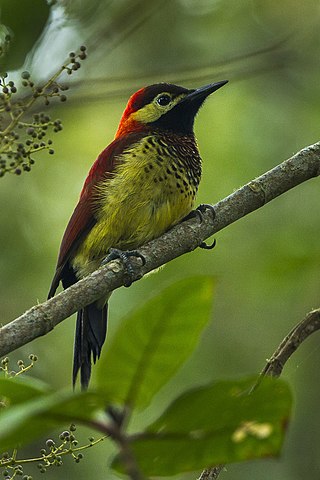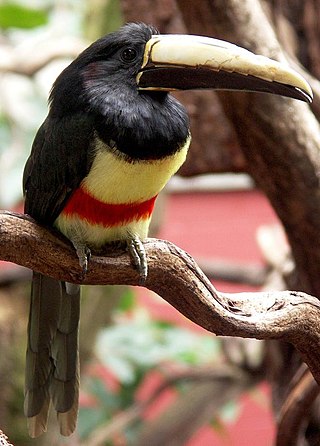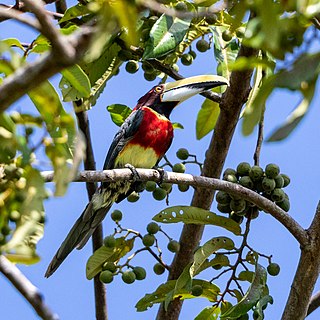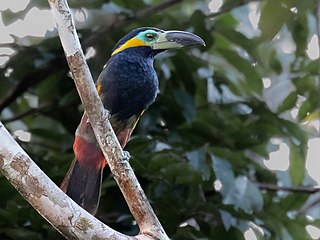
The collared aracari or collared araçari is a near-passerine bird in the toucan family Ramphastidae. It is found from Mexico to Colombia and Venezuela.

The fiery-billed aracari or fiery-billed araçari is a near-passerine bird in the toucan family Ramphastidae. It is found in Costa Rica and Panama.

The yellow-throated toucan is a Near Threatened species of bird in the family Ramphastidae, the toucans, toucanets, and aracaris. It is found from Honduras south into northern South America and beyond to Peru.

The red-breasted toucan or green-billed toucan is a bird in the family Ramphastidae, the toucans, toucanets, and aracaris. It is found in Argentina, Brazil, Bolivia and Paraguay.

The chestnut-eared aracari or chestnut-eared araçari is a near-passerine bird in the toucan family Ramphastidae. It is found in Argentina, Bolivia, Brazil, Colombia, Ecuador, Paraguay, and Peru.

The crimson-mantled woodpecker is a species of bird in subfamily Picinae of the woodpecker family Picidae. It is found in Bolivia, Colombia, Ecuador, Peru, and Venezuela.

The black-necked aracari or black-necked araçari is a near-passerine bird in the toucan family Ramphastidae. It is found in Brazil, French Guiana, Guyana, Suriname, and Venezuela.

The ivory-billed aracari or ivory-billed araçari is a near-passerine bird in the toucan family Ramphastidae. It is found in Brazil, Colombia, Ecuador, Peru, and Venezuela.

The curl-crested araçari or curl-crested araçari is a near-passerine bird in the toucan family Ramphastidae. It is found in Bolivia, Brazil, and Peru.

The red-necked aracari or red-necked araçari is a near-passerine bird in the toucan family Ramphastidae. It is found in Bolivia and Brazil.

The pale-mandibled aracari or pale-billed araçari is a near-passerine bird in the toucan family Ramphastidae. It is found in Ecuador and Peru.

The lettered aracari or lettered araçari is a near-passerine bird in the toucan family Ramphastidae. It is found in Bolivia, Brazil, Colombia, Ecuador, and Peru.

The brown-mandibled aracari is a near-passerine bird in the toucan family Ramphastidae. It is found in Bolivia, Brazil, and Peru.

The many-banded aracari or many-banded araçari is a near-passerine bird in the toucan family Ramphastidae. It is found in Brazil, Colombia, Ecuador, Peru, and Venezuela.

The golden-collared toucanet is a near-passerine bird in the toucan family Ramphastidae. It is found in Bolivia, Brazil, Colombia, Ecuador, and Peru.

The citron-throated toucan is a near-passerine bird in the family Ramphastidae, the toucans, toucanets, and aracaris. It is found in Colombia and Venezuela.

The black-throated toucanet is a near-passerine bird in the toucan family Ramphastidae. It is found in Bolivia, Brazil, Ecuador, and Peru.

Wagler's toucanet is a species of bird in the toucan family Ramphastidae. It is endemic to southwestern Mexico.

The white-throated toucanet or greyish-throated toucanet is a near-passerine bird in the toucan family Ramphastidae. It is found in Colombia, Ecuador, and Venezuela.





















